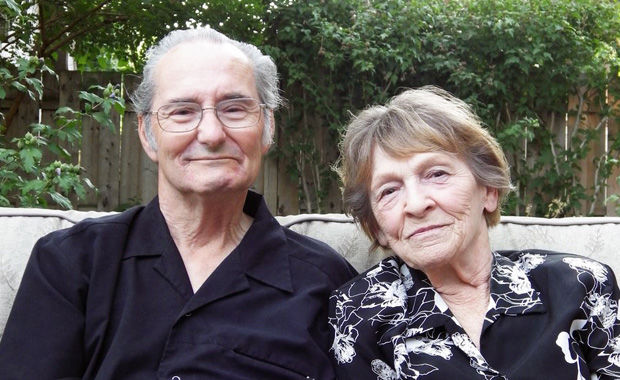A “Simple, Elegant” New Device is Saving Heart Patients from Sudden Cardiac Arrest
Research and Innovations When Carol Johnson found out she needed an implantable cardioverter defibrillator (ICD), a device that prevents death from sudden cardiac arrest, she did a lot of research.

She decided she wanted to get the newest version of the device and wouldn’t take no for an answer. Johnson, who suffered three heart attacks before having bypass surgery in 1999, was delighted when she finally found a cardiologist who would refer her to a specialist that could implant the device.
In March 2014, Dr. Jeff Healey, an associate professor in the Division of Cardiology, Department of Medicine at McMaster University, fitted Johnson with the subcutaneous implantable cardioverter defibrillator (S-ICD).
Unlike the traditional ICD, which is implanted in the shoulder area and uses leads (wires with electrodes) that extend through the veins into the heart to monitor its rhythm, the S-ICD is implanted on the side of the chest and the leads are placed under the skin above the breastbone with no components of the S-ICD entering the blood vessels or the heart.
Like many people using the new device, Johnson is happy with it. “For the first few days after the procedure, I walked around worried that I would get a shock any second but then I got used to it,” says the 72-year-old. “Now, I don’t even notice it’s there.”
Undeniable benefits
Use of the traditional ICD became widespread in the late 1990s, more than two decades after it was pioneered by a team of doctors at a hospital in Baltimore, MD. The battery-powered device keeps track of the patient’s heart rate and if it detects an abnormal one, it delivers an electric shock through the leads to restore a normal rate. Without this help, the patient’s heart could stop beating altogether.
“The S-ICD provides the benefits of the traditional ICD without many of the drawbacks because it leaves the heart and blood vessels alone and intact...”
Sudden cardiac arrest is a medical emergency. If not treated immediately, it causes death. It’s one of the leading causes of death among adults over the age of 40.
ICDs have proven very effective in preventing sudden cardiac arrest in patients with various heart conditions. Studies indicate ICDs have a role in preventing cardiac arrest in patients who are at risk of having (but have not yet had) life-threatening ventricular arrhythmias, which are abnormal heart rhythms that originate in the bottom chambers of the heart.
The ICD also has the ability to function as a pacemaker. In this capacity it can make sure the heart does not beat too slowly and can correct certain types of inappropriate fast heart rhythms.
Use of the traditional ICD has undeniable benefits but it also has some drawbacks, including possible vascular obstruction (decreased blood flow caused by the obstruction of blood vessels), thrombosis (a clot formed in a blood vessel or heart) and even cardiac perforation (hole in the heart).
Also, it is possible that after a number of years traditional leads may break, which could result in inappropriate shocks from the ICD or an inability to deliver a life-saving shock. This means some patients may need to have them replaced several times over the course of their lives. If removal of old leads is needed, the procedure can be challenging and can lead to complications, including death.
Furthermore, some patients have blocked veins, recurring heart infections and other conditions that rule out the use of a traditional ICD altogether.
A “simple, elegant” solution
The S-ICD provides the benefits of the traditional ICD without many of the drawbacks because it leaves the heart and blood vessels alone and intact — so, although it can’t function as a pacemaker, it’s a better option for many heart patients like Johnson.
Also, the device is placed under the armpit, where it can’t be seen while the patient is wearing street clothes, and this makes it especially appealing to fashion-conscious women. Healey describes it as “a simple, elegant solution” for many people.
He emphasizes that by preventing sudden cardiac arrest, ICDs “really do save lives.” He adds that heart patients in Canada have access to quite a few specialists who “are educated about the S-ICD and are good at implanting it.”
Great sense of security
Johnson and her husband Jerry Randall, 69, were installing a sunroof in their trailer in July when they received more heart related news. A medical exam revealed that Jerry, who had suffered a massive heart attack in 1991, also needed an ICD.
Encouraged by his wife’s glowing reviews and a preference for getting a device to protect him against sudden cardiac arrest that didn’t have to go into the heart, he requested the S-ICD. Healey performed the procedure and the couple became the first husband-wife team in Canada to both get the new device. Randall’s experience with it has been as positive as that of his wife, who praises Healey for his ability to explain medical procedures and devices in plain language.
“Jerry got his device put in a few weeks ago and he is doing well. I am fine too,” says Johnson, who recently spent a weekend camping in her trailer near Peterborough, On., along with her husband and other family members. “With the S-ICD we can still enjoy life’s activities and we feel comfortable while doing so. This increased sense of security is just great.”



